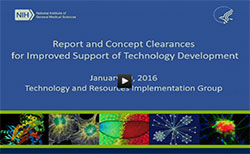Of all the institutes and centers at NIH, NIGMS receives the most Academic Research Enhancement Award (AREA, R15) applications and funds the most AREA grants. This is probably because the faculty and students at eligible institutions, which have not been major recipients of NIH research grant funds, typically focus on basic research using model organisms and systems.
As Sally Rockey of the NIH Office of Extramural Research has noted, the new AREA funding opportunity announcement includes additional questions reviewers are expected to address that are related to the program’s goals of supporting meritorious research, strengthening the research environment of eligible institutions and exposing students to significant research.
With the next AREA application deadline coming up on February 25, I’d like to point out how and where applicants might address the new review considerations.
SIGNIFICANCE: If funded, will the AREA award have a substantial effect on the school/academic component in terms of strengthening the research environment and exposing students to research? Include a summary discussion at the end of the Research Plan, but provide most of the information on lab space, required equipment and facilities, and the availability of students to participate in the proposed research in the Resource page of the application. You and your institution should also include a description of the current research environment and of students who have continued in the biomedical sciences. In the Significance section as well as at the end of the Research Plan, discuss how the potential R15 support would enhance the research environment and increase the number of students exposed to meritorious research. Please remember that the research proposed should be significant, have an impact on the field and be well justified.
INVESTIGATOR: Do the investigators have suitable experience in supervising students in research? Take advantage of the Biosketch Personal Statement to provide specific information about current and former students participating in your research projects. Highlight publications with student co-authors in the Biosketch, and describe the role of students to be supported on the research project and which aim they will help with in the Budget/Personnel Justification and in the timeline at the end of the Research Plan.
APPROACH: Does the application provide sufficient evidence that the project can stimulate the interests of students so that they consider a career in the biomedical or behavioral sciences? As noted above, address this question in the Resource page and the Biosketch Personal Statement with a discussion of students who have previously worked on aspects of the research and who plan to pursue scientific careers. At the end of the Research Plan, I highly recommend including a list of students and a timeline for what each of them would be doing and what research question or approaches they would be exposed to during the R15 support period.
ENVIRONMENT: Does the application demonstrate the likely availability of well-qualified students to participate in the research project? Address this question in both the Resource page and the Biosketch Personal Statement by discussing your record of recruiting interested students who are excited about doing research and helping you accomplish your specific aims. Does the application provide sufficient evidence that students have in the past or are likely to pursue careers in the biomedical or behavioral sciences? As indicated above, with assistance from your institution, use the Resource page to provide a description of students who have majored in the biomedical sciences and who have gone on to graduate or medical school or other biomedical science careers. Use the Biosketch Personal Statement to describe students you have supervised.




